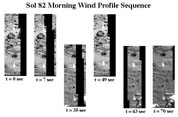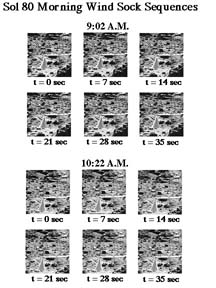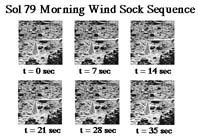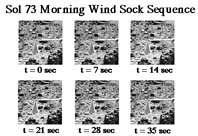 windprofile_sol82.jpg
windprofile_sol82.jpg |
| This set of images shows the Pathfinder wind socks on the morning of Sol
82 (September 25). The top frames show the upper and middle sock and the
bottom frames show the middle and lower socks. Movement of the lower and
middle sock is apparent. Deflections of the three wind socks are used to
estimate characteristics of the wind speed boundary layer profile. |
 windsock_sol80_th.jpg
windsock_sol80_th.jpg |
| This set of images shows the Pathfinder upper wind sock during two time
periods on the morning of Sol 80 (September 23). The interval between frames
within each sequence is one second. There is no obvious movement of the
sock, indicating little or no wind at this elevation (about 1 meter above
the surface). At other times during the mission, deflections of this and
two lower wind socks have been used to estimate characteristics of the wind
speed boundary layer profile. |
 windsock_sol79_th.jpg
windsock_sol79_th.jpg |
| This sequence of images shows the Pathfinder upper wind sock on the morning
of Sol 79 (September 22). The interval between frames is seven seconds.
As in the images posted on the web for Sol 73, there is no obvious movement
of the sock, indicating little or no wind at this elevation (about 1 meter
above the surface). At other times during the mission, deflections of this
and two lower wind socks have been used to estimate characteristics of the
wind speed boundary layer profile. |
 windsock_sol73.jpg
windsock_sol73.jpg |
| This sequence of images shows the Pathfinder upper wind sock on the
morning of Sol 73 (September 16). The interval between frames is seven seconds.
There is no obvious movement of the sock, indicating little or no wind at
this elevation (about 1 meter above the surface). At other times during
the mission, deflections of this and two lower wind socks have been used
to estimate characteristics of the wind speed boundary layer profile. |
MARS PATHFINDER MISSION STATUS
26 September 1997, 3:00 a.m. PDT
The Earth rose over Mars this morning at 4:00 p.m. PDT and
the Sun rose at 6:30 p.m. PDT.
The data received during our 2.5 hour transmit session indicated
that the spacecraft and rover are in good health. We received less data
than expected from the deep space station located in Canberra Australia
due to bad weather. Although we expected to drive the rover today, we were
not able to do so due to critical Mars Global Surveyor operations which
occurred at the same time and required extra DSN support.
So, we contacted the spacecraft after it woke up at 3:00 p.m.
PDT, made sure it was healthy and then verified that the expected super
resolution imaging data and ASI/MET measurements were being collected.
We played the rover wakeup song Slud by Jive of Clay, reminding
us of what the area near our landing site was like 4.5 billion years ago.
Earth set on Mars will be at 4:45 am and the Sun will set at 6:30 a.m. PDT
on September 26th.
The spacecraft will sleep from 5:17 a.m. and until 9:00 p.m.
tomorrow PDT. We should receive data from the spacecraft from between 10:00
p.m. and 3:30 a.m. this time tomorrow. We are planning for the rover to
drive towards toward Mermaid Dune.
For further information on the Mars Pathfinder Mission, please
call our Mission Status Report line at 1-800-391-6654. | 


